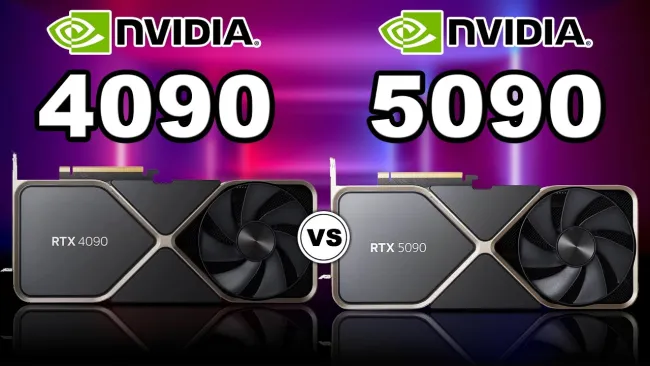RTX 5090 vs. RTX 4090: A Comprehensive Look at Nvidia’s Next-Gen GPU Battle
The GPU market always ignites excitement whenever Nvidia unveils a new flagship graphics card. The Nvidia GeForce RTX 4090 has reigned as a powerhouse in the high-end GPU segment, offering unmatched performance for gaming, content creation, and AI-driven tasks. However, with rumors swirling about its successor, the RTX 5090, the tech world is abuzz with speculation on how it will stack up against the RTX 4090.
In this comprehensive comparison, we’ll delve into the architectural innovations, performance benchmarks, features, power efficiency, and overall value of these two GPUs. By the end, you’ll know whether the RTX 5090 lives up to the hype—and whether it’s worth the potential upgrade cost—or if the RTX 4090 still holds its ground as a top-tier choice.
1. Architectural Innovations
A GPU’s architecture underpins its performance, efficiency, and capabilities. Let’s break down the architectural differences between the RTX 5090 and RTX 4090.
RTX 4090: Ada Lovelace Architecture
- Process Node: Built on TSMC’s 4nm process, the RTX 4090 is a marvel of modern engineering, boasting 76.3 billion transistors.
- CUDA Cores: With 16,384 CUDA cores, the RTX 4090 excels in parallel processing, making it ideal for gaming, rendering, and AI workloads.
- Ray Tracing Cores: Third-generation ray tracing cores deliver realistic lighting, shadows, and reflections, enhancing visual fidelity in games and professional applications.
- Tensor Cores: Fourth-generation Tensor cores power DLSS 3 (Deep Learning Super Sampling), which uses AI to upscale lower-resolution images in real-time, boosting frame rates without sacrificing quality.
RTX 5090: Blackwell Architecture (Rumored)
- Process Node: The RTX 5090 is expected to utilize TSMC’s 3nm process, enabling more transistors and better power efficiency.
- CUDA Cores: Early leaks suggest the RTX 5090 may feature up to 20,000 CUDA cores, significantly enhancing gaming performance, rendering speeds, and AI capabilities.
- Ray Tracing Cores: Fourth-gen ray tracing cores could further improve ray tracing performance, enabling more intricate lighting effects and higher frame rates.
- Tensor Cores: Fifth-gen Tensor cores may debut with the RTX 5090, potentially introducing DLSS 4 with even greater image quality and performance gains.
2. Performance Comparison
Performance is the deciding factor for most users when selecting a GPU. Here’s how the RTX 5090 and RTX 4090 compare across various use cases.
Gaming Performance
- RTX 4090: Already a gaming juggernaut, the RTX 4090 delivers 4K gaming at ultra settings with ray tracing, often exceeding 100 FPS in demanding titles. DLSS 3 further boosts frame rates, solidifying its status as a top-tier gaming GPU.
- RTX 5090: Rumored to deliver a 60–70% performance increase over the RTX 4090, the RTX 5090 could make 8K gaming with ray tracing a realistic possibility, redefining high-end gaming.
Content Creation and Rendering
- RTX 4090: With 24GB of GDDR6X memory and exceptional compute power, the RTX 4090 is a go-to choice for 3D rendering, video editing, and AI-driven workflows.
- RTX 5090: Expected to enhance content creation with faster rendering, improved AI acceleration, and potentially more VRAM, the RTX 5090 will appeal to professionals in animation, VFX, and machine learning.
AI and Machine Learning
- RTX 4090: Tensor cores and AI capabilities make the RTX 4090 a powerful tool for AI research, deep learning, and real-time inference.
- RTX 5090: With fifth-gen Tensor cores and potentially higher memory bandwidth, the RTX 5090 could offer significant advancements in AI performance, making it a prime choice for researchers and developers.
3. Ray Tracing and AI Features
Ray tracing and AI-driven features define Nvidia’s RTX series. Here’s how these GPUs compare.
Ray Tracing
- RTX 4090: Its third-gen ray tracing cores deliver stunning visuals, though higher resolutions with ray tracing can still strain performance.
- RTX 5090: Fourth-gen ray tracing cores are expected to handle complex lighting effects more efficiently, offering better frame rates without compromising visual quality.
DLSS and AI Upscaling
- RTX 4090: DLSS 3 revolutionized gaming by using AI to generate frames and upscale images in real-time, significantly enhancing performance.
- RTX 5090: If DLSS 4 debuts, it could elevate AI upscaling with even better image quality and performance gains, making the RTX 5090 an enticing upgrade for gamers and creators.
4. Power Efficiency and Cooling
Power consumption and cooling solutions are crucial for high-end GPUs.
Power Consumption
- RTX 4090: With a TDP of 450W, the RTX 4090 demands a robust power supply and efficient cooling.
- RTX 5090: While more powerful, the RTX 5090 may improve efficiency through architectural advancements, though its TDP could still range between 450–500W.
Cooling Solutions
- RTX 4090: Its massive cooler handles heat effectively but can be challenging to fit in smaller cases.
- RTX 5090: Advanced cooling solutions may be required, potentially advancing air and liquid cooling technologies further.
5. Pricing and Value Proposition
Price is always a key factor in upgrade decisions.
- RTX 4090: Launched at $1,599, the RTX 4090 is a premium choice for users demanding top-tier performance.
- RTX 5090: Expected to launch at $1,799 or higher, the RTX 5090 offers significant performance gains but may not be cost-effective for everyone.
6. Who Should Upgrade?
- RTX 4090 Owners: Unless you need cutting-edge performance for 8K gaming or professional workloads, upgrading might not be necessary.
- RTX 30-Series or Older GPU Owners: The RTX 5090 represents a substantial leap in performance, making it a worthwhile upgrade.
- Content Creators and Professionals: Improved ray tracing, AI capabilities, and memory bandwidth make the RTX 5090 a compelling option for GPU-accelerated workflows.
7. Final Thoughts
The Nvidia GeForce RTX 5090 is poised to be a groundbreaking GPU, offering substantial performance gains over the RTX 4090. With architectural advancements, enhanced ray tracing, and improved AI capabilities, it has the potential to redefine high-end gaming and professional workflows.
However, the RTX 4090 remains a powerful card capable of handling the latest games and applications with ease. Whether the RTX 5090 is worth the upgrade will depend on your needs, budget, and desire for cutting-edge technology.
